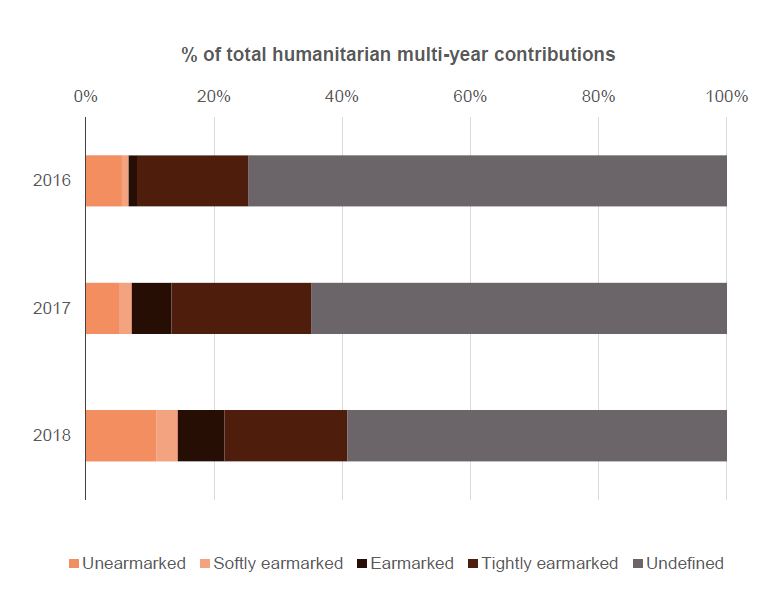Multi-year humanitarian funding: Global baselines and trends: Chapter 4
Earmarking of funding from donors
DownloadsFigure 3: Available data on earmarking shows the majority of donors’ reported multi-year contributions are earmarked

The majority of multi-year funding reported by donors between 2016 and 2018 did not indicate the level of earmarking. The share of multi-year humanitarian contributions without a level of earmarking fell from 75 percent in 2016 to 59 percent in 2018. Where data is available on earmarking of donor contributions, the majority of it is earmarked. Funds classified as earmarked or tightly earmarked grew as a proportion of multi-year funding where earmarking data was provided from 74 percent in 2016 to 80 percent in 2017, then fell to 65 percent in 2018.
Source: Development Initiatives, based on data provided bilaterally and from the International Aid Transparency Initiative (IATI). Data was collected between April and August 2019.
Notes: The dataset shown in the chart covers nine institutional donors that are Grand Bargain signatories and reported to our survey. Contributions from two donors were not included in this chart because they did not provide data covering all three years. Multi-year funding also refers to funding agreements ranging between 12 and 24 months when defined as multi-year by the donor. UK Department for International Development data was collected from IATI and includes some technical operation costs. Data is in constant 2017 prices.
An average of 65% of the multi-year funding reported by donors for the period 2016 to 2018 did not indicate the extent of earmarking. While the share of multi-year humanitarian contributions without a defined level of earmarking dropped from 75% in 2016 to 59% in 2018, the level remains significant. As such, only a partial picture can be drawn from the available data. Much greater transparency of the earmarking of multi-year funding is needed.
Where data did indicate the extent of earmarking, “earmarked” or “tightly earmarked” allocations accounted for the majority of all multi-year humanitarian funds, in all three years between 2016 and 2018.
- These “earmarked” and “tightly earmarked” funds grew as a proportion of multi-year funding for which an earmarking category was provided, from 74% in 2016 to 80% in 2017, before decreasing to 65% in 2018.
- The largest share of reported multi-year funding for which an earmarking category was provided was “tightly earmarked” [1] , ranging between 47% and 69% of total multi-year contributions from 2016 to 2018. Over the same period, “earmarked” contributions grew from 5% to 18% of total multi-year contributions with earmarking information.
- Of those funds with an earmarking category indicated, the proportion of “unearmarked” multi-year funding is low, at 22% in 2016 and 15% in 2017. However, the proportion of total multi-year humanitarian funding identified as “unearmarked” did grow in 2018, to 27% of funds identified with an earmarking category.
Aid organisations reported that the multi-year humanitarian grants they receive are largely earmarked. This perception is confirmed in the above data analysis, although the reported increase in the extent of earmarking of multi-year funding is not found in the analysis of reported multi-year contributions for 2018, where the proportion that were identified as “tightly earmarked” or “earmarked” decreased. However, it is possible that the large share of multi-year funding for which a level of earmarking was not provided may mask higher levels of earmarking of multi-year funds in 2018 as well.
The high proportion of multi-year funds which are earmarked is perceived by aid organisations to restrict their choice of multi-year programmes. Large aid organisations often pool together multiple income sources, earmarked to varying degrees, to develop a suite of activities that make up a multi-year programme. The more flexible the funding is, the greater the opportunity for organisations to optimise how these funds are used within programmes. However, stipulations on country, sector or activity are perceived to be diluting the benefits of predictable funding by compelling aid organisations to channel their programmes toward pre-defined priorities. This limits their ability to adapt programming to changing needs or context.
Downloads
Notes
-
1
Analysis based on the Grand Bargain document identified degrees of earmarking: unearmarked, softly earmarked, earmarked and tightly earmarked, Available at: https://www.agendaforhumanity.org/sites/default/files/resources/2018/Jan/Grand_Bargain_final_22_May_FINAL-2.pdfReturn to source text